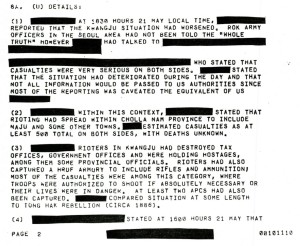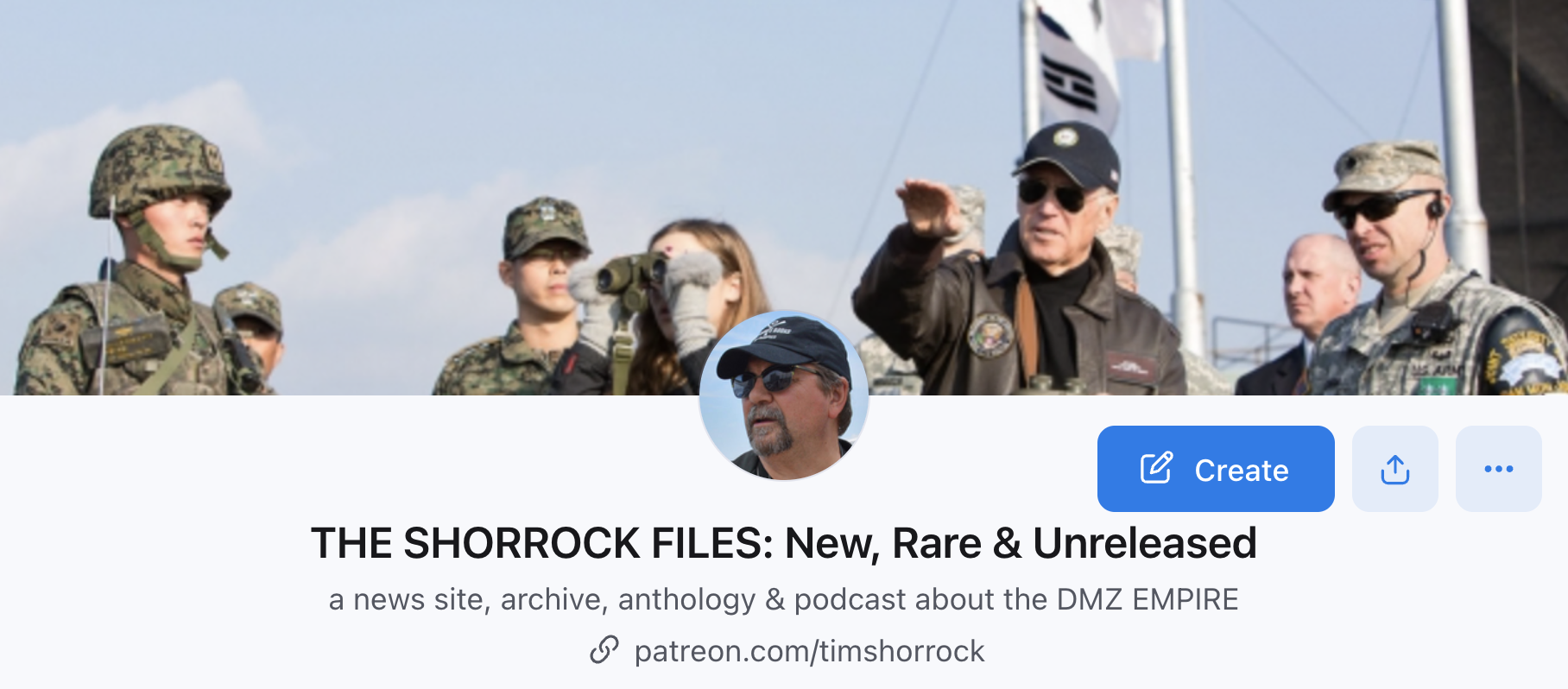This is an online database of the 4,000 declassified US government documents on the US role in the Gwangju Uprising of 1980. The original copies of the documents known in Korea as the “Cherokee File,” are permanently stored and available for research at Gwangju’s 5.18 Archives in South Korea.

BOX 1, FILE 2: DOD-DIA Reports, December 1979-May 1980
This file contains Defense Intelligence Agency (DIA) reports to the Department of Defense (DOD) about the domestic situation inside South Korea from the October 26, 1979, assassination of Park Chung Hee, through the Gwangju Uprising of May 1980. They are significant because the DIA had some of the best intelligence of the US government throughout this period and, as these documents show, relied on a variety of secret sources within the Korean military as well as in academia and even within the student-led democratic movement. With few exceptions, the blacked-out portions of the documents refer to the names and identities of the DIA’s sources.
The file contains two extremely significant documents. The first, dated May 21, includes the first mention in any US document of a firing order – in this case, “authorization” – to the Special Warfare Command forces who killed dozens of people on this day.
Another significant document, dated May 22, has the DIA’s Korean sources predicting that the uprising in Kwangju could spread nationwide and that the general population could join in. Considering the date (the crucial White House meeting on Kwangju happened a few hours later), this report could have been understood in Washington as a sign that the entire country was about to be engulfed in an uprising – a determination that could have influenced the Carter White House to put down the Kwangju Uprising with military force. (Note: the descriptions are by date, but the files are randomly organized).
10/22/1979 – Document describes how martial law has been proclaimed in Pusan, with biographical material on the martial law commander in the city.
10/27/1979 – DIA reports on Park Chung Hee assassination. Details of Special Forces deployments back to Seoul.
10/31/1979 – Document discusses ROK Army attitudes about Park Chung Hee’s possible successor. Also includes analysis of General Chong, Martial Law Commander.
12/19/1979 – DIA discussion with ROK military attaches in Japan and their attitudes towards Park Chung Hee. All express opposition to “rapid liberalization.”
12/19/1979 – DIA analysis of Gen. Chu Young Bok, just appointed as defense minister – “a hardliner of the old school.”
12/28/1979 – DIA discussion of reports from South Korean government of possible North Korean attack on the South. “No evidence to support rumors of pending North Korean attack on South Korea.” DIA suspects that it’s “planted by ROK government to unify South Koreans and deflect from political difficulties.”
1/1980 – DIA discusses Korean military analysis of student reaction to Chun Doo Hwan. Information comes from a Korean military source considered “reliable,” with “a reporting relationship” that goes back a year.
5/8/1980 – In this document, General Noh Tae Woo, identified as the “CSC Commander,” informs the DIA that the government is “prepared to use troops” against the huge student-led demonstrations then rocking Seoul and other cities. Noh explains the Army believes it can offer no more compromises with student demands, adding that the military crackdown did not signal “an effort to stifle reform.” The document notes that Noh is close to Chun and part of his 12/12 group.
5/14/1980 – “Source A,” “Source B,” and “Source C” report on student demonstrations. The document includes very detailed reports about different universities and role of “radical” students recently released from prison.
5/15/1980 – DIA report on student demonstrations in Seoul, Taegu and Kwangju. Prime Minister Shin Hyon Hwack has promised “sterner measures” against them.
5/16/1980 – In this cable, Korean Army sources tell DIA that they believe Kim Dae Jung was “directly involved with inciting students to riot.” It also includes details of Chun Doo Hwan’s appointment to be director of the KCIA in April. Later, a cable discusses his resignation in June to “defuse” protests over Gwangju.
5/19/1980 – “Student Unrest in Kwangju.” Report states: “20,000 students are rioting in the streets,” joined by “others,” including workers. Situation is “extremely serious.”
*5/21/1980 – “Situation Update – Kwangju, KS.” This document is significant because it is the only US military report about May 21, the day of the 1 p.m. mass shooting and massacre in downtown Gwangju that ended with Chun Doo Hwan pulling the Special Warfare Command paratroopers out of the city (it should also be read with Ambassador Gleysteen’s report from the same day, “The Kwangju Crisis,” also dated May 21).
The documents also includes what may be the only reference in any US document to a firing order. This may help resolve the question of who is responsible for the first firing of the Kwangju Uprising. It’s important to quote this in full so the context is understood. The document states:
Rioters in Kwangju had destroyed tax offices, government offices and were holding hostages, among them some provincial officials. Rioters had also captured a HRDF [?] armory to include rifles and ammunition; most of the casualties were among this category, where troops were authorized to shoot if absolutely necessary or their lives were in danger.
In other words, the source is saying someone authorized these forces to shoot, if absolutely necessary. Who would have been in the posiition to provide that authority? That is the question.
The DIA source for the document is blacked out and is described by the DIA as “of the highest caliber” who has “confirmed stripping [editing] stories previously reported.” The rest of the report, filed at 6:30 pm local time, states that “the Kwangju situation has worsened,” and that ROK Army officers in the Seoul area had not been told the “whole truth.” The source reports that “casualties were very serious on both sides,” adding that “not all information would be passed to US authorities” [the reason for the deletion is blacked out.] The Korean source states that “rioting” has spread to Naju and other towns, with “estimated casualties as at least 500 total on both sides, with deaths unknown” [in the afternoon shooting, 54 had been killed, according to historical records].
Cable also notes “growing anti-American flavor to recent events” because of the “US decision to release ROK OPCON forces for riot control duty in Kwangju has greatly increased the anti-American mood.”
5/21/1980 – Document describes transport of Cholla-born officers to Kwangju.
*5/22/1980 – Document describes civil unrest and martial law. DIA sources say there is “growing acceptance that the civil unrest, riots, etc., in Kwangju will spread.” They also predict “civil strife throughout the country,” and that “this time the public will join the students in the streets.” DIA officer states that “all three sources are retired,” and none are “actively engaged in anti-government activities.” As I mention above, this report could have been understood in Washington as a sign that the entire country was about to be engulfed in an uprising – a determination that may have influenced the Carter White House to put down the Kwangju Uprising with military force.
Use links below to view documents in PDF format:
- Military Attitudes toward Recent ROK Political Situations| October 15, 1979
- Martial Law is Proclaimed in Pusan, KS | October 18, 1979
- Death of Park Chun Hee, President, Republic of Korea | October 27, 1979
- Army Attitudes toward Political/Military Situation | October 31, 1979
- Comments on ROK Developments & New Defense Minister | December 19, 1979
- Situation in Korea | December 28, 1979
- Student Reaction to MG Chon Tu Hwan | January 7, 1980
- Junior Officer Reaction to Promotion of Chon Tu Hwan | March 1-7, 1980
- Assignment of New KCIA Chief | April 14, 1980
- Rationale for LTG Chon Tu Hwan’s Appointment to KCIA | April 21, 1980
- Remarks Concerning Present Student Situation & Use of Troops | May 8, 1980
- Student Demonstration Seoul | May 13, 1980
- Student Unrest Update | May 14, 1980
- ROK Student Demonstrations (1) | May 14, 1980
- ROK Student Demonstrations (2) | May 14, 1980
- Continuing Student Demonstrations & Insight to Causes | May 15, 1980
- ROK Student Unrest | May 16, 1980
- ROK Army & Student Unrest | May 16, 1980
- ROK Update | May 18, 1980
- Student Unrest | May 18, 1980
- Student Unrest & Martial Law | May 18, 1980
- Imposition of Martial Law | May 18, 1980
- Extension of Martial Law | May 18, 1980
- Student Unrest – Kwangju, KS | May 19, 1980
- Situation Update – Kwangju, KS | May 21, 1980
- Transport of Cholla-Born Army Officers to Kwangju | May 21, 1980
- Civil Unrest & Martial Law | May 22, 1980
- Resignation of Chon Tu Hwan as KCIA Chief | June 2, 1980
